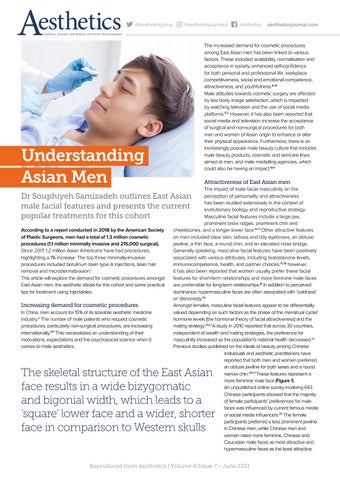@aestheticsgroup
Understanding Asian Men
@aestheticsjournaluk
Aesthetics
aestheticsjournal.com
The increased demand for cosmetic procedures among East Asian men has been linked to various factors. These included availability, normalisation and acceptance in society, enhanced self-confidence for both personal and professional life, workplace competitiveness, social and emotional competence, attractiveness, and youthfulness.6-10 Male attitudes towards cosmetic surgery are affected by low body image satisfaction, which is impacted by watching television and the use of social media platforms.11,12 However, it has also been reported that social media and television increase the acceptance of surgical and non-surgical procedures for both men and women of Asian origin to enhance or alter their physical appearance. Furthermore, there is an increasingly popular male beauty culture that includes male beauty products, cosmetic and skincare lines aimed at men, and male modelling agencies, which could also be having an impact.13,14
Attractiveness of East Asian men
The impact of male facial masculinity on the perception of personality and attractiveness Dr Souphiyeh Samizadeh outlines East Asian has been studied extensively in the context of male facial features and presents the current evolutionary biology and reproductive strategy. Masculine facial features include a large jaw, popular treatments for this cohort prominent brow ridges, prominent chin and According to a report conducted in 2018 by the American Society cheekbones, and a longer lower face.15-17 Other attractive features of Plastic Surgeons, men had a total of 1.3 million cosmetic on men included clear skin, tattoos and tidy eyebrows, an obtuse procedures (1.1 million minimally invasive and 215,000 surgical). jawline, a thin face, a round chin, and an elevated nose bridge. Since 2017, 1.2 million Asian Americans have had procedures, Generally speaking, masculine facial features have been positively highlighting a 1% increase. The top three minimally-invasive associated with various attributes, including testosterone levels, procedures included botulinum toxin type A injections, laser hair immunocompetence, health, and partner choices;15-18 however, 1 removal and microdermabrasion. it has also been reported that women usually prefer these facial This article will explore the demand for cosmetic procedures amongst features for short-term relationships and more feminine male faces East Asian men, the aesthetic ideals for this cohort and some practical are preferrable for long-term relationships.18 In addition to perceived tips for treatment using injectables. dominance, hypermasculine faces are often associated with ‘coldness’ or ‘dishonesty’.19 Increasing demand for cosmetic procedures Amongst females, masculine facial features appear to be differentially In China, men account for 15% of its sizeable aesthetic medicine valued depending on such factors as the phase of the menstrual cycle/ industry.2 The number of male patients who request cosmetic hormone levels (the hormonal theory of facial attractiveness) and the procedures, particularly non-surgical procedures, are increasing mating strategy.20,21 A study in 2010 reported that across 30 countries, 3-5 internationally. This necessitates an understanding of their independent of wealth and mating strategies, the preference for motivations, expectations and the psychosocial science when it masculinity increased as the population’s national health decreased.22 comes to male aesthetics. Previous studies published on the ideals of beauty among Chinese individuals and aesthetic practitioners have reported that both men and women preferred an obtuse jawline for both sexes and a round narrow chin.23,24 These features represent a more feminine male face (Figure 1). An unpublished online survey involving 643 Chinese participants showed that the majority of female participants’ preferences for male faces was influenced by current famous media or social media influencers.25 The female participants preferred a less prominent jawline in Chinese men, while Chinese men and women rated more feminine, Chinese and Caucasian male faces as most attractive and hypermasculine faces as the least attractive.
The skeletal structure of the East Asian face results in a wide bizygomatic and bigonial width, which leads to a ‘square’ lower face and a wider, shorter face in comparison to Western skulls
Reproduced from Aesthetics | Volume 8/Issue 7 - June 2021
















